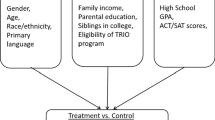Abstract
This paper investigates the determinants of the salaries of recruits to university teaching. The data sources are the University Grants Committee survey of recruits 1967–68, and a special survey of recruits to twenty universities undertaken by the Higher Education Research Unit at L.S.E. in 1969.
Salaries of recruits are regressed on grade, age, subject, university type, quality of first degree and highest degree attained. The regression results generally accord with the theoretical predictions. However, the more substantive result is that (excluding grade) the age variable is the dominant influence on salary. The influence of subject taught on salary is surprisingly low given that the different subjects comprise non-competing groups. This tentatively suggests that equity considerations are more important to universities than economic efficiency considerations when universities set recruits' salaries.
Résumé
L'article vise à tester l'influence des différents déterminants du salaire parmi les enseignants débutant à l'Université. Les données proviennent de deux sources: l'enquête menée par la Commission des Crédits pour les Universités (University Grants Committee) sur les enseignants débutant en 1967–1968 et une enquête spéciale faite sur les enseignants débutants de vingt universités sous la responsabilité du Groupe de Recherche sur l'Enseignement Supérieur de la L.S.E. (London School of Economics).
La recherche repose sur une analyse des corrélations entre les salaires de ces enseignants et des variables telles que le grade, l'âge, la discipline, le type d'université, la nature du premier et du plus haut diplôme obtenu. Les résultats de l'analyse de régression concordent en règle générale avec les prévisions théoriques. Cependant, le résultat le plus net consiste en ce que (abstraction faite du grade) c'est la variable de l'âge qui exerce l'influence la plus forte sur le niveau du salaire. L'influence de la discipline d'enseignement sur le salaire est étonnament faible, étant donné que le découpage en disciplines ne définit pas des groupes en compétition. Ceci suggère que les considérations d'équité jouent un rôle plus important que les considérations de rendement économique aux yeux des universités lorsqu'elles fixent le salaire des débutants.
Similar content being viewed by others
References
Andrews, F., Morgan, J. and Sonquist, J., (1967),Multiple Classification Analysis: a report on a computer program for multiple regression using categorical predictors Ann Arbor: Survey Research Center.
Becker, G. S., (1964),Human Capital: A Theoretical and Empirical Analysis, with Special Reference to Education Columbia University Press: New York.
Bowen, W. J. (1963), “University salaries: faculty differentials”Economica, 30(120), 341–359, (November).
Kish, L. and Frankel, M. R. (1970), “Balanced repeated replications for standard errors”,Journal of the American Statistical Association, 65, 1071–1094.
Metcalf, D. (1972), “Pay” in Williamset al The Structure of the Academic Labour Market, (forthcoming).
Metcalf, D. and Bibby, J. (1970),Salaries of Recruits to University Teaching (Draft), UT/RM/15, (LSE: Higher Education Research Unit).
Metcalf, D. and Bibby, J. (1970), “University salaries: faculty differentials”, HERU Reprint No. 40, fromEconomica (November 1970).
National Board for Prices and Incomes (1970),Report No. 145: Standing Reference on the Pay of University Teachers in Great Britain: Second Report Cmnd. 4334. London: H.M.S.O.
Reder, M. W., (1955), “The theory of occupational wage differentials”,American Economic Review 44, pp. 833–852.
Reder, M. W., (1964), “Wage structure and structural unemployment”,Review of Economic Studies, XXXI (October).
Tolles, N. A. and Melichar, E. (1968), “Studies of the Structure of economists' salaries and income”American Economic Review, 58 (5, Part 2) pp. 1–153 (December).
Williams, G.et al (1970),The Labour Market for University Teachers: an Interim Report, (LSE: Higher Education Research Unit, January, mimeographed).
Author information
Authors and Affiliations
Additional information
The authors are respectively lecturer in economics at LSE and lecturer in statistics at the University of St. Andrews. This paper reports one aspect of a wider study of the academic labour market undertaken in the Higher Education Research Unit at LSE. The study was originally sponsored by the National Board for Prices and Incomes. However, the views expressed are solely those of the authors. We are grateful to Gareth Williams for helpful comments on an earlier draft (Metcalf and Bibby 1970), which was more heavily statistical and is obtainable from HERU on request.
Rights and permissions
About this article
Cite this article
Metcalf, D., Bibby, J. Salaries of recruits to university teaching in Britain. High Educ 1, 287–297 (1972). https://doi.org/10.1007/BF01957554
Issue Date:
DOI: https://doi.org/10.1007/BF01957554



